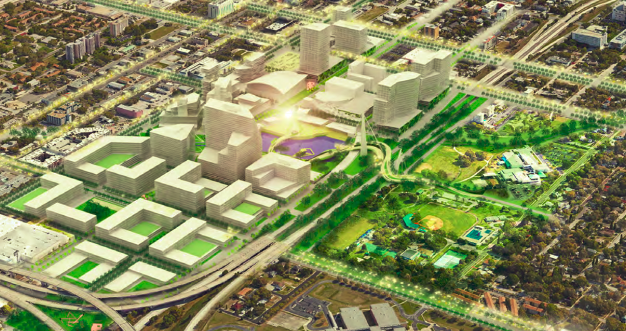Pictured above: An image from the second conceptual master plan by HKS Architects. The firm drew up plans with and without a new baseball stadium based on whether or not the Rays plan to stay in St. Petersburg.
Courtesy of HKS Architects
By Jonah Hinebaugh
Leather baseball mitts and the crack of wooden bats echoing off empty seats could be a thing of the past in St. Petersburg by 2030.
Instead, the 86 acres that make up Tropicana Field could be redeveloped into a mixed-use site and reintegrated as part of the community. And USF wants to be part of that discussion.
According to conceptual master plans designed by HKS Architects, it would include a “district center supporting entertainment and retail surrounded by an innovation, technology and research campus, cultural entertainment, hotel, convention (center) and offices.”
According to designs within the plan, the research and development campus would be around 22 acres in total –– or 25 percent of the space.
The architectural firm designed two plans based on whether a new, publicly funded stadium would be constructed.
But any construction or renovations related to the project most likely won’t begin until after 2027, when the lease –– binding the Tampa Bay Rays to play all home games at the field –– between the baseball club and the City expires.
Regional Chancellor Martin Tadlock said he’s been in contact with the city to ensure USF St. Petersburg is at the table if, and when, redevelopment takes place.
“(The city) said they’re planning on USF and probably one other university as well to have a conversation about becoming part of that plan, so that’s what I wanted,” he said.
“If they develop a plan that you see on the website, going forward I’d hope that USF has a presence there on that site (and a) partnership with the city,” he said. “(The partnership would be) probably in a very specialized kind of research and development environment that allows our students (to have) additional opportunities, and community people as well.”
In the design plans, HKS notes partnerships between medical centers and the university are a strong possibility.
“Existing tech and medical centers nearby, such as USF St. Petersburg and Johns Hopkins All Children’s Hospital, present an opportunity to tie the St. Petersburg Innovation District to the site,” the document says. The partnership could drive future economic development and education while expanding the institutional presence already in the area, it said.
Tadlock echoed the sentiments, saying a working partnership between the College of Marine Science and medical centers would present good opportunities due to the location of the city.
“There’s a lot of research that happens in this region, especially in the sciences and in the healthcare industry,” he said. “So, we have a desire moving forward to bring together the marine sciences and human health because both, of course, are very interdependent.
“We’re sitting where that really matters, and so I would hope that there’s an opportunity to present those two broad fields together in a way that benefits people who live here.
“Why not start addressing the gap and bringing those folks together? Maybe one aspect of a research center could be focused on the intersection of the marine and life sciences, and what the applications are for people in those industries,” he said.
The plan also seems to include language appealing to the communities in south St. Petersburg.
It includes reconnecting the city grid, creating footpaths for access to the new area from the Campbell Park area and a reexamination of the possibilities for the future of I-175.
Originally, plans to redevelop the Gas Plant District –– where the Trop stands now –– began in the 1980s.
According to a 1998 St. Petersburg Times article, the City told the Gas Plant community in 1979 that it would get “a new neighborhood of up-to-date, affordable housing, with an industrial park for light manufacturing on the west end. Buildings worth saving on the east end would be refurbished.”
Three years later, the City decided to level the neighborhood to make way for a new stadium. As a result, 522 households were relocated, more than 30 businesses moved or closed and 285 buildings were demolished by 1986.
In 1998, the Rays began its first season on the soil of a once vibrant district.
A recent Tampa Bay Times article said Kriseman sees this redevelopment as a way to reconnect the city and bring St. Petersburg back together.
“I know they want to lift the communities, and the city as a whole, in whatever they do in developing that property,” Tadlock said. “It’s not just to bring in a certain level of clientele and exclude others. I think that’s not in the desires or the plan for the city at all.”



